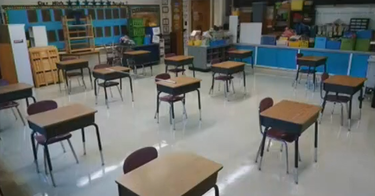‘A monumental task’: GCSD explains plans for reopening
GUILDERLAND — Six feet apart: That state directive on social distancing set the foundation for the plan to reopen Guilderland schools in the midst of the coronavirus pandemic.
“It’s the lynchpin to everything that follows,” said Superintendent Marie Wiles.
The six-foot rule determines how many students can ride on a school bus as well as how many students can fit in a classroom; that, in turn, has led to plans that stagger school schedules and reconfigure grade groupings as well as having older students learning remotely on set days of the week.
Over 750 questions were submitted about the reopening plan that the district posted on its website last Thursday. On Tuesday, school leaders, in a video-conference setting, answered those questions, which had been grouped into categories.
The district has set up a special email address just to handle questions about the reopening plan: reopening@guilderandschools.net
Schools across the state must complete their reopening plans by July 31. Governor Andrew Cuomo is to decide during the first week of August on school reopening based on regional metrics.
All 10 regions of the state are currently in the fourth and final phase of reopening the economy, which is required for reopening schools. Albany County is in the Capital Region. For schools to reopen, the COVID-19 infection rate in the region has to be 5 percent or less on a 14-day rolling average. The Capital Region currently is well below 2 percent.
Each school district is required to plan for in-person learning; remote learning; and a hybrid model, including both.
Guilderland is asking parents to complete a form on the eSchoolData portal to make a semester-long commitment to having their student learn either remotely or in-person, and also whether they intend to have their child ride a school bus.
If schools are forced to close, instruction at Guilderland will transition to remote-only learning. The suburban district serves about 5,700 students — in five elementary schools, a middle school, and a high school.
Assistant Superintendent for Instruction Demian Singleton said during the video conference that many parents had questions on the difference between home-schooling and remote learning.
In home-schooling, which is “not anything new,” Singleton said, parents provide instruction at home. They have to go through an extensive process to get approval to do this, conforming to requirements from the State Education Department.
In remote learning, which well may take place at home, the parent is not the instructor; a Guilderland teacher is. “The school district is still owning the responsibility to supply instruction,” he said.
“Monumental task”
Wiles called developing the reopening plan “a monumental task,” involving over 120 stakeholders — teachers, administrators, parents, and community members with expertise in fields as diverse as law and medicine. The volunteers worked in six committees: facilities, instructional program, social and emotions support, health and safety, human resources, and extracurricular activities including performing arts and athletics.
The district surveyed faculty, students, and parents on the effectiveness of remote learning used after the district was abruptly forced to close its schools in March. Focus groups were also held with students and parents.
In Tuesday’s video presentation, posted online at the district’s website, Wiles said the district’s primary goal is to ensure safety of students, faculty, and staff by following state guidelines.
In some cases, Guilderland’s plan is more stringent than the guidelines, for example, requiring students to wear masks during instructional periods.
The plan has two other guiding principles: prioritizing in-person learning for younger students and for students who need special assistance, and being flexible.
Wiles said she frequently tells her staff, “I hope you’re comfortable with ambiguity because we’re in the midst of it here.”
She commented in the video conference, “A big caveat here … This plan is a work in progress. Please anticipate changes. Please be patient … Changes will be made to better serve our students and to make sure we’re keeping everybody safe.”
Parents will have an important role to play.
Allan Lockwood, principal of Guilderland Elementary School, answered a question for parents asking what they could do now to prepare students for school: “Have students wear masks right now,” he said rather than waiting till their first day of school, so they can get comfortable with them.
Lockwood also spoke of the importance, on returning to school, of building “the classroom communities that are so important to learning.”
Each day, before their children get on the school bus, parents are to take their temperature. If it’s greater than 100 degrees Fahrenheit, the child needs to stay home.
“We’re going to ask parents to be our partners in keeping everyone safe,” said Wiles.
Departing from its usual protocols, Guilderland is encouraging parents to drive their children to and from school or to have students walk to school where it is safe.
Only one child will be allowed to sit on a bus seat, except for siblings who can sit together; this means about 20 students, rather than the usual 66, will fit on a bus. Children who are not wearing masks when they board a bus will be handed one by the driver.
Bus runs will be staggered by grade level, with the youngest students starting earliest. Students in seventh through 12th grades won’t start school till 10 a.m. They’ll be dismissed at 4:30 p.m., making after-school bus runs impossible.
The district still wants to offer extra-curricular activities though; many of them will be conducted remotely.
The state guidelines recommend 12 feet of distance between students who are singing or playing wind instruments. This also applies to physical-education classes.
David Austin, the district’s new athletic director, said kids will have physical-education classes both in person and remotely. “We are going to be outside early and often,” he said.
“Our focus is on low-risk, no-contact that requires little equipment,” said Austin, adding, “We’ll have to be really creative with our curriculum.”
Under current state guidelines, interscholastic sports are not permitted. The New York State Public High School Athletic Association has delayed the start of the fall sports season until at least Sept. 21.
Austin said that students who are learning remotely, rather than in-person, will still be able to participate if school sports are allowed.
Grouping students
Unlike last spring, Guilderland students’ work will be graded in the fall semester as it was before the pandemic. Also, attendance will be taken, both of students in the classroom and of students learning remotely.
Students in kindergarten through sixth grade will receive daily in-person instruction. Those in kindergarten through fourth grade will attend their neighborhood elementary school as always.
Fifth- and sixth-graders, however, will be housed at Farnsworth Middle School. Rather than being intermixed as middle-schoolers are, the elementary students will be grouped together as they were in their neighborhood schools, just in a new location.
Since, with desks 6 feet apart, only 14 students, on average, fit in a classroom, students will be grouped in cohorts of 14. They will largely learn from their classroom teachers but may at times be supervised by other school staff for independent work or live-streamed instruction in the building.
“Our intention is to have students fully engaged in learning in either space,” said Singleton, adding that the district is striving to have “certified instructional staff” with students when they are not with their classroom teacher.
Seventh-graders will remain at Farnsworth, using an alternate-day model where they receive live in-person instruction every other day, alternating with live remote instruction.
Students in eighth through 12th grades will be housed at the high school. They will receive in-person instruction for two consecutive days followed by two consecutive days of remote instruction. When eight- and ninth-graders are at school, students in 10th, 11th, and 12th grades will be home, learning remotely.
Then, for the next two days, the groups will switch, with the older students learning at school and the younger students learning remotely from home.
Students who are in self-contained, special-education programs in all grades will be on-site daily.
Those in kindergarten through sixth grades will receive special-education services each day in person. Students in seventh through 12 grades will receive special-education services both in person and remotely.
Students who participate in co-teaching, consultant teacher services, resource rooms, and tutorials will follow the same hybrid model as their general-education peers, supported by their special-education teachers or case managers.
Lisa Knowles, who oversees special education for Guilderland, noted that students have been in classes this summer in a tent set up next to Guilderland Elementary School. “They’ve adapted really well, she said, adding, “Our kids are really resilient.”
Knowles also advised, in the midst of the turmoil of rearranging nearly everything about the school day, “Realizing our students take cues from us — parents and teachers — so as best as we can, foster resilience and realize we’re in this together.”


